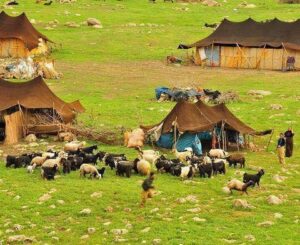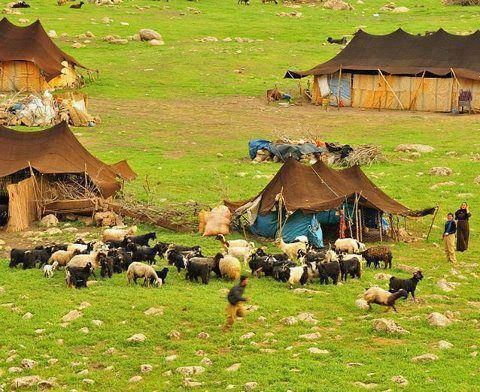Reshmal (Black Tent) is an authentic Kurdish term, a compound word derived from “Resh” (black) and “Mal” (home). Kurdish nomads have used it from ancient times to the present day, as it is well-suited to their nomadic lifestyle. Nomadic life does not involve permanent settlement; instead, nomads constantly move between warm and cool areas, traveling to mountain regions in the hot seasons and returning to warmer plains in winter. This movement ensures that their animals have access to pastures, as nomads rely on animal products for their livelihood. A key feature of the Reshmal is its portability: it can be easily dismantled, packed, and reassembled, making it ideal for nomadic life. Additionally, the Reshmal stays cool in summer and warm in winter.
The Reshmal is made from goat hair. After the goats are sheared, the hair is collected and spun into threads and strings. Then, a loom is set up, the patterns of the pieces are determined, and the weaving begins. The goat hair is naturally water-resistant; when it rains, the fibers swell, creating a tighter weave that prevents water from seeping through.
Three types of pieces are made for the Reshmal: top pieces, side pieces, and bottom pieces. The top sections have poles that support the tent, with the number of poles varying according to the size of the Reshmal—the larger the Reshmal, the more poles are required. The Reshmal must be securely tied down on all sides with ropes to protect it from strong winds and rain. The interior of the Reshmal is typically divided into sections, including separate areas for men and women, sleeping quarters, and a cooking area. A small trench is dug around the Reshmal to channel rainwater away and prevent it from getting under the tent. Additionally, aside from the thick fabric made of goat hair, the surroundings of the Reshmal are enclosed with reeds.
A Reshmal cannot be set up just anywhere; wind direction, elevation, and geographical location must be carefully considered. The site should be flat and level, ideally at a high point on the mountainside, to shield it from strong winds.
The Reshmal represents the nomadic heritage of the Kurdish people, particularly those who practiced transhumance (the seasonal movement between lowlands and highlands).
Beyond being just a shelter, the Reshmal serves as a center for social gatherings, storytelling, and the preservation of cultural traditions.
While the basic design remains consistent, there can be regional variations in size, decoration, and construction techniques among different Kurdish groups.
Although urbanization has reduced the number of nomadic Kurds, some still maintain the tradition of using Reshmals, especially during seasonal migrations or cultural festivals.
The craftsmanship required to make a Reshmal is passed down through generations, involving intricate weaving techniques and knowledge of proper setup.
The Reshmal is not just a practical dwelling but also a symbol of Kurdish identity and their connection to the land and traditional way of life.
Prepared by
Ahmed Farhan


